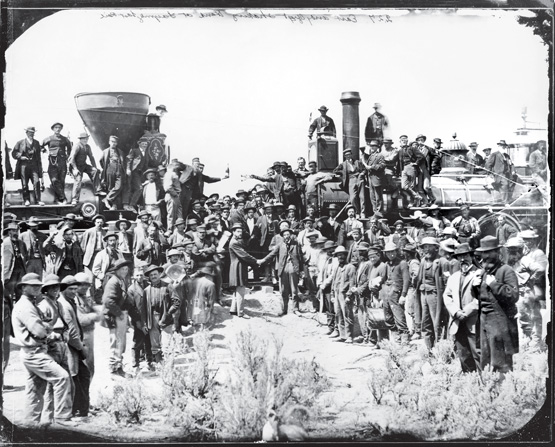 |
|||||
|
The 1800's:
1
2
3
4
5
6
7
8
9
10
< previous
next >
Railroads played a crucial role in the movement of men and equipment during the military campaigns. But following the war, railroad-building became a true mania, as the burgeoning country wrapped itself in an increasingly dense network of rails. Track mileage doubled in the decade following the war. The level of investment was far greater than anything ever seen in the merchant marine. The country's East and West coasts were finally joined by rail in 1869, when the rival Union Pacific and the Central Pacific railroads, which Lincoln had urged to build the first transcontinental railroad, celebrated their linkup by driving a golden spike into a tie at Promontory Point, Utah. As the nation grew westward, it turned inward. The U.S. merchant marine languished and shipyards, which had boomed during the war, stood empty. At the behest of increasingly powerful U.S. industry, Congress erected a bulwark of protective tariffs. As it had since its founding, the JoC crusaded relentlessly for free trade and sound money. In an era marked by corruption at all levels of industry and government, the paper called for reform. It campaigned for untarnished congressional candidates to replace what it called, "the salary grabbers, subsidy receivers and other traitors to their constituents."
During this era, the paper was steered by two men, David Stone, who had taken over from Hallock at the start of the Civil War, and William C. Prime, a lawyer who invested part of his fortune in the paper. The two converted the paper from a partnership into a corporation. Prime soon retired to become president of the Metropolitan Museum of Art. Though continuing as one of the lead investors, Prime left Stone in sole control. Stone devoted himself to the paper, writing most of the editorials and many of the page one stories. But he neglected the paper's physical plant, allowing its technology to become outdated. Type was still set by hand in an era when most papers had switched over to linotype machines. Stone was frugal to the point of penury. He was generous in approving dividends to stockholders but niggardly in approving expenses on upkeep. The paper lost ground to its competitors, including the Daily Commercial Bulletin, founded in 1865 and owned by William Dodsworth, a friend of Stone's. But unlike his friend, Dodsworth believed it was more important to invest earnings in plant and equipment than to pay it out to investors. In 1893 Prime and Stone agreed to sell the JoC to Dodsworth and merge it with the Commercial Bulletin. Though Dodsworth was the acquirer, he retained the JoC's name. The new paper became The Journal of Commerce and Commercial, a name that was to be maintained through the 1990s. The merged paper benefited enormously from the Commercial's new presses and linotype machines, each of which could replace three or four men setting type by hand, one letter at a time. The papers also had complementary advertising support. The Commercial drew advertising from the grocery and provisions business, from insurance and banking. The JoC was strong in shipping and chemicals, textiles and insurance. When Dodsworth took over, he immediately laid off most members of both staffs. He didn't want writers who couldn't write on the newfangled typewriting machines, or compositors who couldn't run linotypes. The 1800's: 1 2 3 4 5 6 7 8 9 10 < previous next > |
||||
| © Copyright 2005 United Business Media. All rights reserved. | |||||
